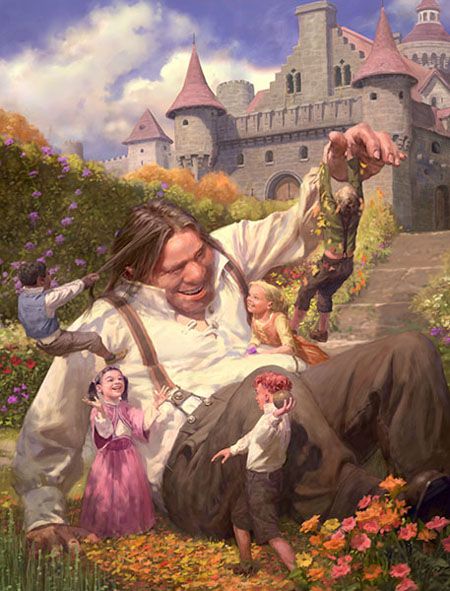Let's Read the 4e Monster Manual/Vault: Giants

This article is part of a series! Click here to see the other entries.
Giants are present in D&D since the beginning, making up one of the games most famous “monster ladders”. How famous? It got a whole module trilogy to itself, named Against the Giants, which got reprised and homaged in several editions after its debut on AD&D 1st Edition. You could have named the game Gaols & Giants without changing anything else, and no one would find it odd that they’re in the title.
As you’d expect from monsters with such an exalted pedigree, they are present in both books. Between both of them we have no less than six giant types, each with multiple stat blocks, so I’m going to give a general overview of giant-kind in this post and cover each type in its own installment.
On the Origin of Giants
Giants in 4e all share a common origin: they were among the first beings created by the primordials, stepping out into the newly-created world before it had even cooled from the forge. Their purpose in life was to assist their masters in exploring and shaping this new creation. This means they could dispute the efreets’ claims of being the firsborn children of the Primordials, if they cared to.
Well, if you want to get technical about it, the beings created directly by the primordials are Titans. They they embody the qualities of the Elemental Chaos to such a degree that their bodies are made of elemental matter instead of that gross meat stuff. The Titans went about their mission for a while, but eventually found out that the world was too large for them to do it efficiently. So they created servitors of their own to help them in turn.
These servitors are the Giants proper. They’re smaller than their titanic progenitors, and made of flesh and bone because they’re more closely aligned with the world than with the Elemental Chaos. (From this point on, I’m using capital-G Giants to mean both titans and giants).
In the course of their mission, the Giants multiplied and spread throughout the world and the planes, and when the Primordials retreated from the world they inherited it, and created one of its first empires. It was around this time that the creations of the gods began to appear, and the Giants were already there to enslave them. Most notable among these slaves were the dwarves, children of Moradin, whose entire population endured a centuries-long period of cruel servitude.
When the Dawn War started, the titans and giants sided with the primordials. Though there weren’t many of them, their immense individual power gave them victory in many battles, filling their castles with pillaged loot. Attrition from the long war took its toll even on these mighty beings, though, allowing the sudden dwarven rebellion to succeed and deal the final blow to their empire.
Today’s giants are still sore about their downfall. They dream of casting down the gods and rebuilding what they had, but they never managed to organize enough to pull it off in all the intervening millenia. Today they live in scattered and isolated communities, who fight each other as much as they terrorize the surrounding small ‘uns. The causes for all this infighting are a bit opaque and convoluted. They probably stretch back long enough that those Viking tales of multi-decade feuds sound quaint to a giant.
Giant Stat Overview
The most famous giant and titan signature trait is that they’re really big! Giants are on the larger end of Large, and Titans cross over into Huge. All of them have the Giant keyword as well, and though most giants have the Elemental origin due to the story above, there are some interesting exceptions. Each giant type has further signature traits that will be discussed in their own posts.
Level-wise, they range from early Paragon to late Epic tier. Within that range, giants are usually regulars, with Titans being both Elite and a few levels stronger than their corresponding giants.
Between the Monster Manual and the Monster Vault, we get the following giant types, arranged from weakest to strongest: Earth, Ice, Fire, Death and Storm. Each type presents one or more giant stat blocks and one Titan.
That first category includes Hill Giants - Stone giants also exist and fall under Earth, but don’t appear in the first Monster Manual or on the Vault.
The first three rungs of this ladder comprise the Against the Giants set, which means those modules could make a fine Paragon-tier campaign for 4e.